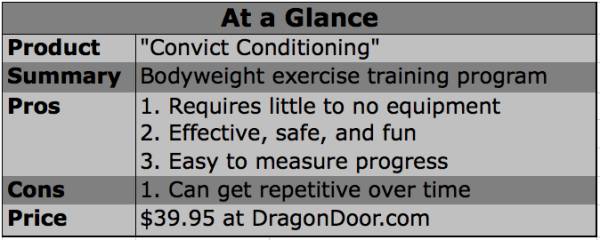
While Paul Wade remains a secretive and elusive character, the techniques he divulges in Convict Conditioning are simple, effective, and obviously useful. Using progressions, you are shown how to work the “Big 6” movements to create your own personal fortress – a strong, injury-resistant, highly functional body.
The “Big 6”:
- Squat
- Pullup
- Leg raise
- Bridge
- Pushup
- Handstand pushup
I hear you thinking, “Well, that’s fine, but I can already do all those pretty well.” That might be true, but you probably haven’t achieved the “mastery level,” as Wade puts it. You might not have perfect form, either. Both form and cadence are stressed many times throughout the book, and there is no doubt that an exercise performed properly yields a better training response with fewer injuries (and keeps you humble.)
 Through detailed instructions, every major movement is broken into ten steps, from beginner to mastery. Within each step, there are rep and set requirements to move on to the next phase. The pushup, for example, begins with wall pushups. When you can perform 3 sets of 50 wall pushups with perfect form and cadence per the instructions, you may begin working incline pushups. The tenth and final step in the progressions is 1 set of 100 one-hand pushups. Per arm.
Through detailed instructions, every major movement is broken into ten steps, from beginner to mastery. Within each step, there are rep and set requirements to move on to the next phase. The pushup, for example, begins with wall pushups. When you can perform 3 sets of 50 wall pushups with perfect form and cadence per the instructions, you may begin working incline pushups. The tenth and final step in the progressions is 1 set of 100 one-hand pushups. Per arm.
So now you know the system the book outlines and you’re thinking, “That’s great, but what does it get me? How is this useful?” For my training I used Convict Conditioning as a ten-week bridge between powerlifting cycles. This turned out to be a smart move for several reasons. First of all, the easy movements that I started out with were terrific active recovery after a long and crushing strength cycle. Next, by paying close attention to form, which is made easier by starting with sub-maximal resistance, I was able to improve muscular endurance, build the mind-muscle connection, and enhance joint flexibility and mobility – aspects of the game that powerlifting is not known for improving.
I am seeing the benefits now that I am back to a powerlifting/strength cycle. My core is noticeably stronger, improving my squat and deadlift numbers; my ankles and hips are more flexible, allowing better form; and my shoulders are more mobile and feel better than they have in a long time, improving my bench press and military press progress.
Unlike highly specialized approaches to strength training, Convict Conditioning includes a great deal of mobility work as part of the training, disabling you from skipping that important piece when you’re tired after a grueling training session. The “Big 6” progressions build strength and improve mobility simultaneously.
Overall, I have to give a big thumbs-up to Dragon Door, Paul Wade, and Convict Conditioning. Attention to detail makes the program very safe even for beginners seeking a basic level of fitness, but there is no lack of challenge for accomplished athletes. If you are a coach, I would recommend this book highly. A new trainee could benefit from an initial 6-week stint of bodyweight-only workouts to get them ready to meet the barbell safely. With the possible exception of a gymnast, there are few who would not benefit from the information in this book. And, the workouts can be a hell of a lot of fun, too.
“Convict Conditioning” is available for $39.95 at DragonDoor.com.
Also check out our review of “Convict Conditioning 2.”






